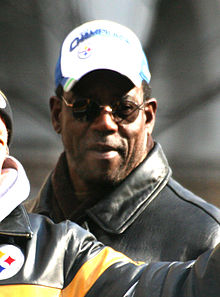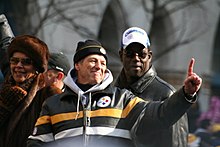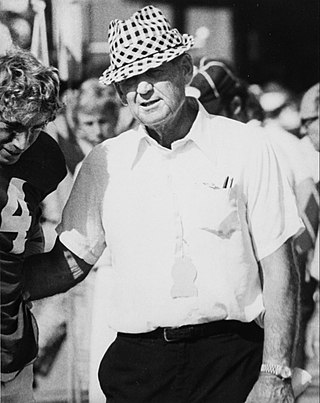
Paul William "Bear" Bryant was an American college football player and coach. He is considered by many to be one of the greatest college football coaches of all time, and best known as the head coach of the University of Alabama football team, the Alabama Crimson Tide, from 1958 to 1982. During his 25-year tenure as Alabama's head coach, he amassed six national championships and 13 conference championships. Upon his retirement in 1982, he held the record for the most wins (323) as a head coach in collegiate football history. The Paul W. Bryant Museum, Paul W. Bryant Hall, Paul W. Bryant Drive, and Bryant–Denny Stadium are all named in his honor at the University of Alabama.
Lee Roy Jordan is an American former professional football player who was a linebacker for the Dallas Cowboys of the National Football League (NFL). After playing college football for the Alabama Crimson Tide under head coach Paul "Bear" Bryant, he played 14 years in the NFL for the Cowboys from 1963 to 1976. He was inducted into the College Football Hall of Fame in 1983.

Kenneth Michael Stabler was an American professional football quarterback who played in the National Football League (NFL) for 17 seasons, primarily with the Oakland Raiders. Nicknamed "Snake", he played college football at Alabama and was selected by the Raiders in the second round of the 1968 NFL/AFL draft. During his 10 seasons in Oakland, Stabler received four Pro Bowl selections and was named Most Valuable Player in 1974. Stabler also helped the Raiders win their first Super Bowl title in Super Bowl XI. He was posthumously inducted to the Pro Football Hall of Fame in 2016.

Evan Bradley Mathis is an American former football guard who played in the National Football League (NFL) for twelve seasons. He played college football for the Alabama Crimson Tide, and was selected by the Carolina Panthers in the third round of the 2005 NFL draft. Mathis also played for the Miami Dolphins, Cincinnati Bengals, Philadelphia Eagles, Denver Broncos and Arizona Cardinals.
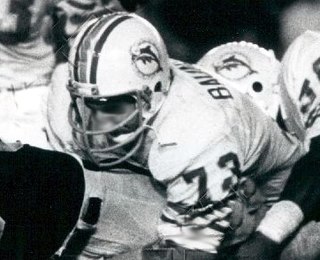
Robert Glenn Baumhower is an American former professional football player who was a defensive tackle for the Miami Dolphins in the National Football League (NFL). He played college football for the Alabama Crimson Tide under coach Bear Bryant from 1973 to 1976 and professionally for Miami under coach Don Shula. He later became a restaurateur.

Trevor Deshea Townsend is an American professional football coach and former cornerback who currently is the defensive backs coach and defensive pass game coordinator for the Detroit Lions of the National Football League (NFL). He previously worked as an assistant coach for the Jacksonville Jaguars, Chicago Bears, New York Giants, Tennessee Titans, and Arizona Cardinals.

DeMeco Ryans is an American professional football coach and former linebacker who is the head coach of the Houston Texans of the National Football League (NFL). Ryans played college football for the Alabama Crimson Tide, where he was named a unanimous All-American.

Lakendrick Tridel Clancy is an American former professional football player who was a defensive tackle in the National Football League (NFL). He was selected by the Pittsburgh Steelers in 2000, having also played for the New York Giants, Arizona Cardinals and New Orleans Saints. He played college football at the University of Mississippi.
Stephen Charles Sloan was an American professional football player who became a college football coach and athletics administrator. He played in college as a quarterback at the University of Alabama from 1962 to 1965 and then spent two seasons in the National Football League (NFL) with the Atlanta Falcons (1966–1967). Sloan then returned to his alma mater as an assistant coach (1968-1970), and then served one year each as an offensive coordinator at Florida State (1971) and Georgia Tech (1972). At Florida State he was on the staff with linebackers coach Bill Parcells. Sloan then got his first head coaching job at Vanderbilt University (1973–1974), where he brought Parcells with him, and at his next job at Texas Tech University (1975–1977), he made Parcells the defensive coordinator. Sloan then went on to the University of Mississippi (1978–1982), and Duke University (1983–1986), compiling a career record of 68–86–3. He returned to Vanderbilt to serve as offensive coordinator for one year (1990) before retiring from coaching. He also served as the athletic director at the University of Alabama (1987-1989), the University of North Texas (1991-1993), University of Central Florida (1993-2002), and the University of Tennessee at Chattanooga (2002-2006), before his retirement in 2006. In 2000, Sloan was inducted into the Tennessee Sports Hall of Fame. He died on April 14, 2024, at the age of 79.

Cecil W. "Hootie" Ingram was an American college football player, coach, and athletics administrator. He played for the University of Alabama from 1952 to 1954 and was selected as an All-SEC defensive back in 1952. He worked as an assistant football coach at several colleges, including the University of Georgia and University of Arkansas before he received a head coaching assignment at Clemson University from 1970 to 1972. He was an administrator with the Southeastern Conference in the 1970s and later served as an athletic director at Florida State University (1981–1989) and Alabama (1989–1995).
Richard Barry Krauss is an American former professional football player who was a linebacker for 12 seasons in the National Football League (NFL).
John Anthony Copeland is an American former professional football player who was a defensive end in the National Football League (NFL) for eight seasons. He played college football for the University of Alabama, was recognized as an All-American and was a member of a national championship team in 1992. He was selected by the Cincinnati Bengals in the first round of the 1993 NFL draft, and he played his entire pro career for the Bengals.
Jeffrey Ronald Rutledge is an American former football player and coach. He played professionally as a quarterback for 14 seasons in the National Football League (NFL). A backup for most of his career, he was a member of the New York Giants team that won a Super Bowl in Super Bowl XXI and the Washington Redskins team that won Super Bowl XXVI.
Amos Jones is an American football coach who was the assistant coach of special projects & situations for the New York Giants of the National Football League (NFL).

Javier E. Arenas is an American former professional football player who was a cornerback in the National Football League (NFL). Arenas played college football for the Alabama Crimson Tide, earned consensus All-American honors, and was a member of a BCS National Championship team. He was selected by the Kansas City Chiefs in the second round of the 2010 NFL draft. He was also a member of the Arizona Cardinals, Atlanta Falcons, New York Jets, and Buffalo Bills of the National Football League (NFL), and the Ottawa Redblacks of the Canadian Football League (CFL).
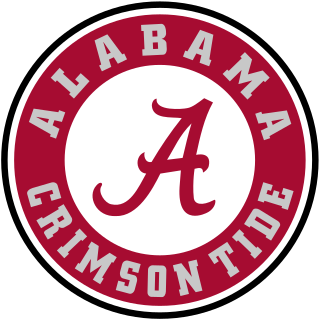
The 2010 Alabama Crimson Tide football team represented the University of Alabama in the 2010 NCAA Division I FBS football season. It was the Crimson Tide's 116th overall season, 77th as a member of the Southeastern Conference (SEC) and its 19th within the SEC Western Division. The team was led by head coach Nick Saban, in his fourth year, and played their home games at Bryant–Denny Stadium in Tuscaloosa, Alabama.

Marcell Dareus is an American former professional football player who was a defensive tackle in the National Football League (NFL). He played college football for the Alabama Crimson Tide, where he was named defensive MVP of the 2010 BCS National Championship Game. Dareus was selected by the Buffalo Bills third overall in the 2011 NFL draft. He also played for the Jacksonville Jaguars.
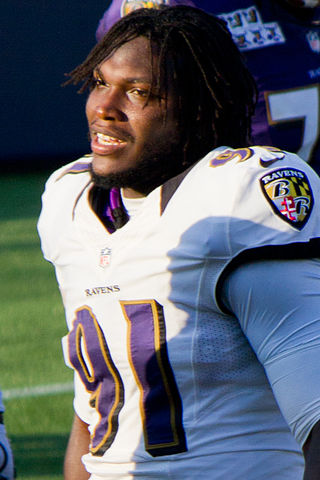
Courtney Tremaine Upshaw is an American former professional football player who was a linebacker in the National Football League (NFL). He played college football for the Alabama Crimson Tide, earning first-team All-American honors in 2011. He was selected by the Baltimore Ravens in the second round of the 2012 NFL draft.

Robert Kendall Luna is a former American football safety in the National Football League (NFL) for the San Francisco 49ers and Pittsburgh Steelers. He played college football at the University of Alabama.
